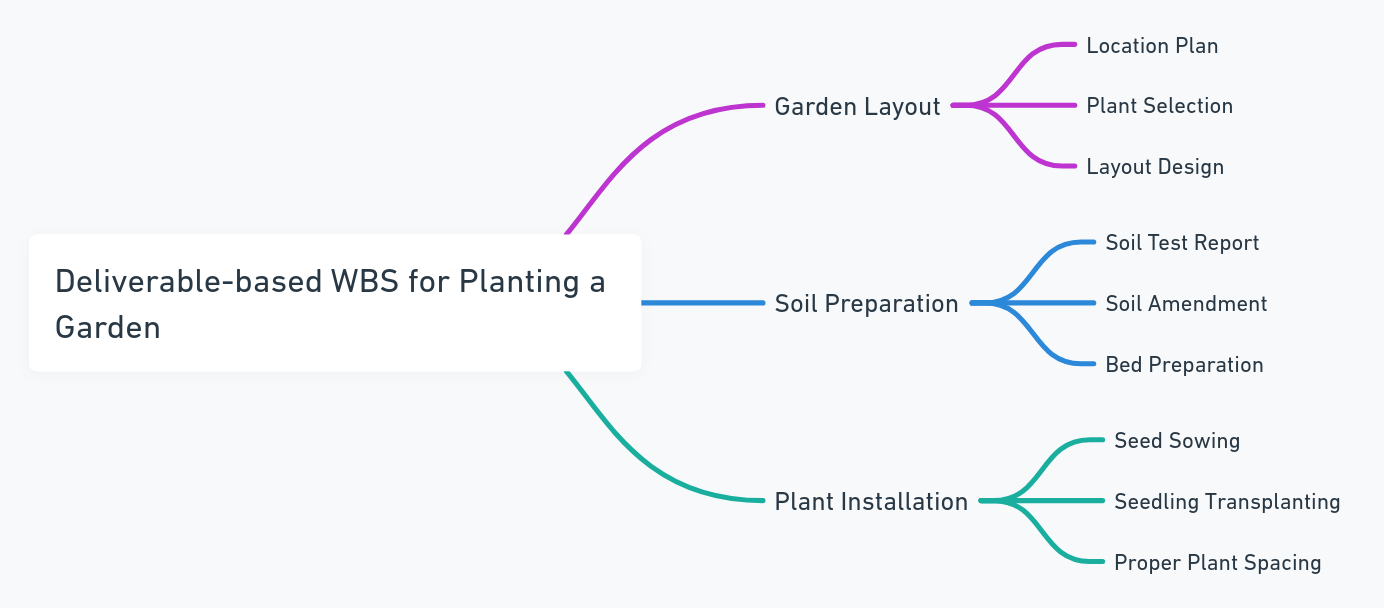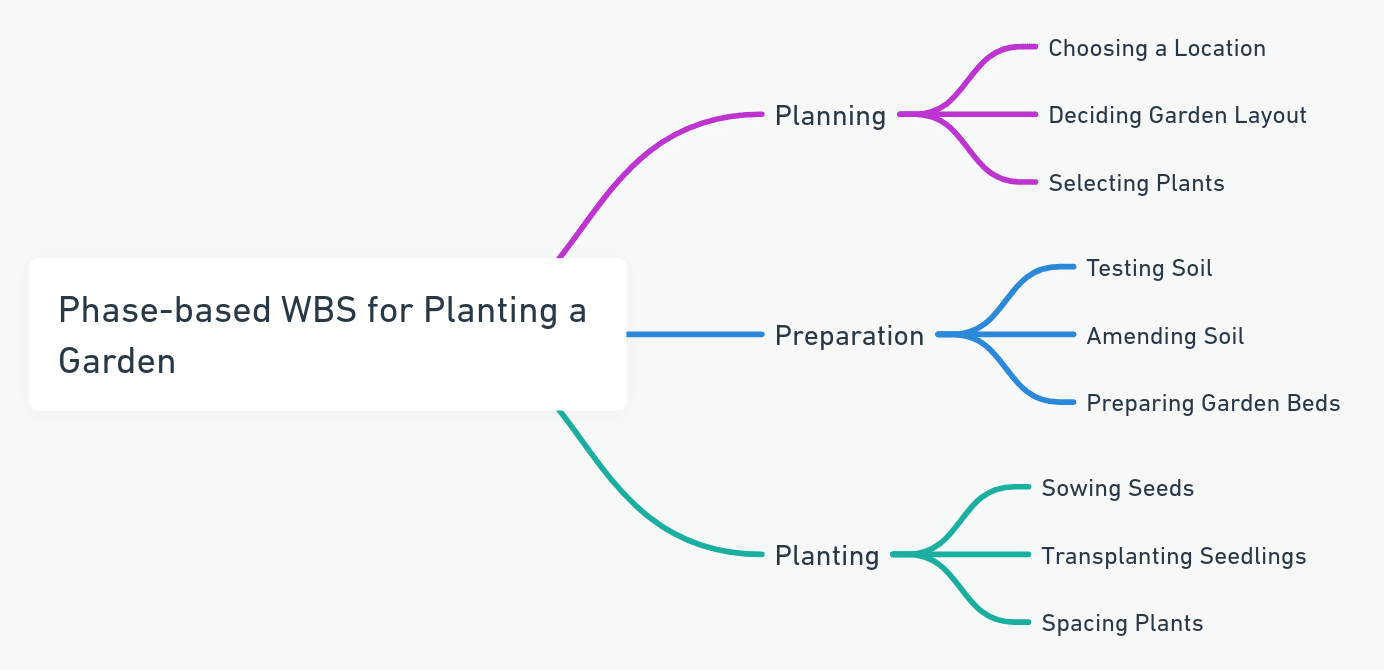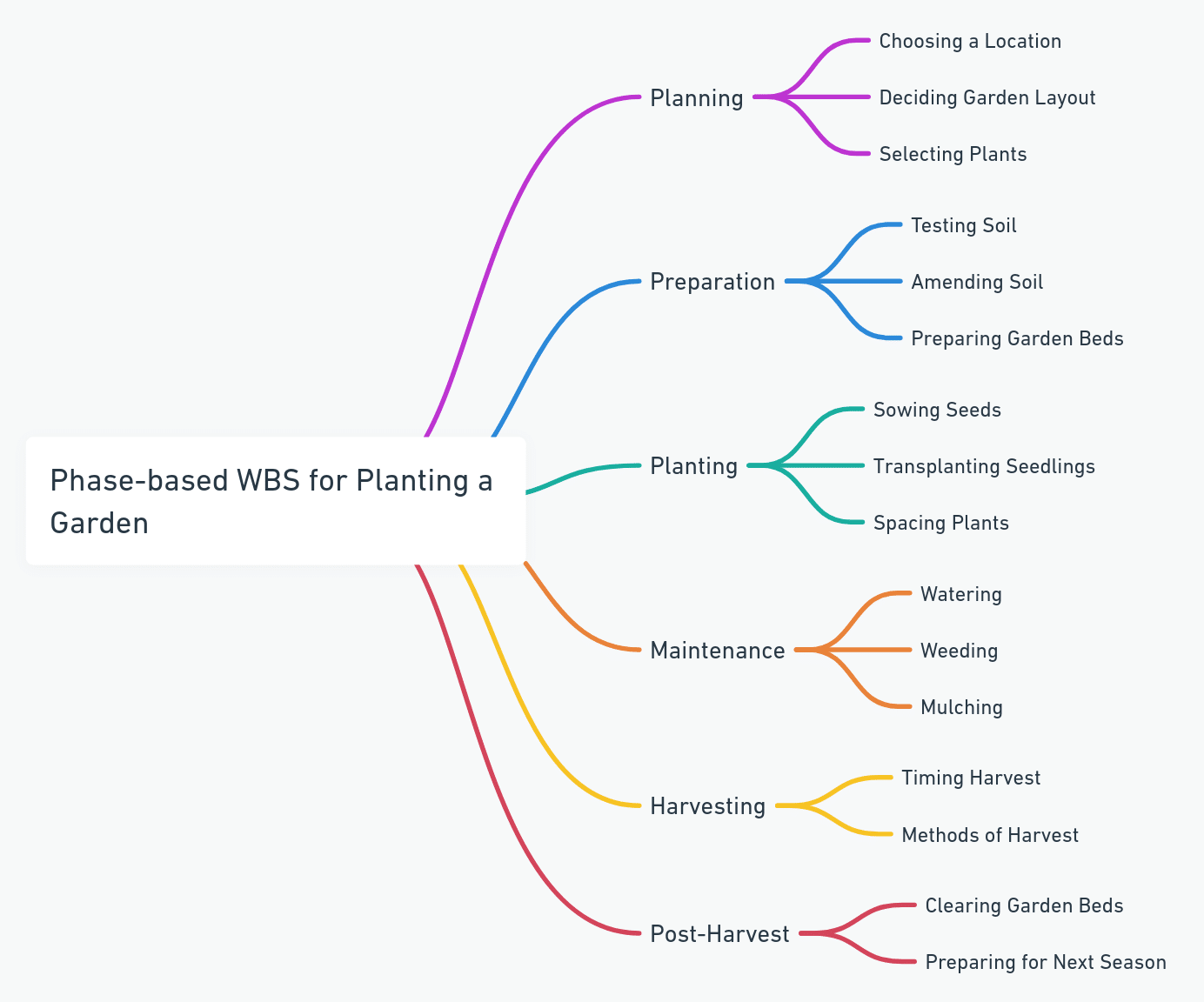When tackling complex projects, it’s easy to feel overwhelmed by the sheer number of tasks involved. That’s where the Work Breakdown Structure (WBS) comes in handy for project managers. In this article, we’ll explore what WBS is and how it can help you break down your projects into manageable pieces, using the simple example of planting a garden.
What is WBS in Project Management?
A Work Breakdown Structure is a way of organizing a project by breaking it down into smaller, more manageable parts. Think of it like a family tree for your project, with the main goal at the top and increasingly detailed tasks branching out below.
A WBS typically follows a simple hierarchical pattern:
- The topmost level is the project itself.
- The next level consists of major deliverables or phases.
- Each subsequent level breaks down into more detailed components.
By breaking the project down in this way, the WBS provides a clear picture of what needs to be done and how everything fits together.
Deliverable vs Phase-based Work Breakdown Structure
When creating a Work Breakdown Structure, project managers typically choose between two main approaches: deliverable-based and phase-based. Each method offers a different perspective on organizing project tasks and can be more suitable depending on the nature of the project.
Deliverable-Based Work Breakdown Structure
A deliverable-based WBS focuses on the project’s end products or outcomes. It helps ensure that all necessary outputs are accounted for and can be especially beneficial in projects where deliverables are tangible or easily identifiable.
For our garden planting project, main deliverables might include Garden Layout, Soil Preparation, and Plant Installation. Let’s examine a deliverable-based WBS for this project:

Phase-Based Work Breakdown Structure
A phase-based WBS, on the other hand, organizes the project by its sequential stages or phases. This approach is often used when the project follows a clear, linear progression.
In our garden planting example, the main phases might be Planning, Preparation, and Planting. Let’s look at a phase-based WBS for this project:

Why Use WBS in Project Management?
A Work Breakdown Structure offers several key benefits for effective project management:
Clarity and Completeness
WBS provides a comprehensive visual of the project scope, helping identify all necessary tasks and revealing relationships between project components. This ensures nothing is overlooked and promotes a clear understanding of the project structure.
Improved Estimation and Planning
Breaking the project into smaller pieces allows for more accurate resource and time estimation, leading to better planning and budgeting.
Team Organization and Progress Tracking
WBS facilitates clear task assignment and responsibility allocation. It also enables efficient progress monitoring at various levels, from broad phases to specific tasks.
WBS Visualization Formats
The most common WBS formats are tree diagrams, mind maps, and tables. Let’s take a look at the pros and cons of each.
WBS Tree Diagram Format
A tree diagram format visually represents the hierarchical structure of a project in a branching layout, similar to an organizational chart. Each node in the tree represents a task, with sub-tasks branching off from their parent tasks. This format is useful for quickly understanding the relationships and dependencies between different parts of a project.
Example WBS Tree Diagram Format

This tree diagram format emphasizes the hierarchical relationships and dependencies between tasks, providing a clear and intuitive visual representation of the project structure.
However, a downside of the tree diagram format is that it extends horizontally the more steps are in the project. As in the above example, the wide format can cause crowding on the screen.
That is why I prefer mind maps for complex projects.
WBS Mind Map Format
Complicated projects with lots of steps can still look great when displayed as a mind map that arranges steps vertically.
To illustrate what I mean, I added extra phases to the WBS example below.
Example WBS Mind Map Format

Pro tip: While making a visualization like that may seem like a lot of work, it is a cinch with AI. I used a Whimsical Diagrams custom GPT to generate these diagrams in seconds. It’s a nifty tool for quickly visualizing project structures.
WBS Table Format
A tabular Work Breakdown Structure (WBS) format is a structured table used to represent the hierarchical decomposition of a project. It includes key columns such as Level, WBS Code, Description, Assigned To, Start Date, End Date, and Notes. This format is useful for detailed project planning and management.
The Level column indicates the hierarchical depth of each task, with higher numbers representing more detailed sub-tasks. The WBS Code provides a unique identifier for each task, typically using a numerical system that reflects the task’s position in the hierarchy (e.g., “1.1” for a sub-task of “1”).
Example Tabular WBS Format
| Level | WBS Code | Description | Assigned To | Start Date | End Date |
| 1 | 1 | Planting a Garden | |||
| 2 | 1.1 | Planning | |||
| 3 | 1.1.1 | Choosing a Location | |||
| 3 | 1.1.2 | Deciding Garden Layout | |||
| 3 | 1.1.3 | Selecting Plants | |||
| 2 | 1.2 | Preparation | |||
| 3 | 1.2.1 | Testing Soil | |||
| 3 | 1.2.2 | Amending Soil | |||
| 3 | 1.2.3 | Preparing Garden Beds | |||
| 2 | 1.3 | Planting | |||
| 3 | 1.3.1 | Sowing Seeds | |||
| 3 | 1.3.2 | Transplanting Seedlings | |||
| 3 | 1.3.3 | Spacing Plants |
This tabular format differs from mind map and tree diagram formats by providing a more detailed and structured view of tasks and their attributes. While mind maps and tree diagrams visually represent the hierarchy and relationships between tasks, the tabular format allows for the inclusion of additional project management details such as assigned personnel and schedule information.
Another advantage of using a table format is that it is easy to make and update in a spreadsheet, and you can share it in almost any document or email.
How to Create Work Breakdown Structure
- Define the project scope. Clearly identify the final deliverable and the project’s main objectives. This sets the foundation for the WBS and ensures that all necessary work is included.
- Identify major deliverables. Break down the project into its major components or deliverables. These should be the significant, high-level elements that are essential to achieving the project’s objectives.
- Decompose deliverables into work packages. Take each major deliverable and subdivide it into smaller, manageable work packages. Continue breaking down the work until you reach a level where the tasks are specific, measurable, and can be assigned to team members.
- Assign codes and create hierarchy. Use a numbering system to create a hierarchical structure that clearly shows the relationships between the work packages. This coding system helps in organizing and tracking the tasks throughout the project.
- Review, validate, and baseline. Review the WBS to ensure that it includes all necessary work packages and that there are no redundancies. Validate the WBS with project stakeholders to ensure agreement on the project scope and breakdown of work. Once validated, establish the WBS as a baseline for measuring progress and making any necessary adjustments.
By following these 5 steps, you can create a comprehensive and logical Work Breakdown Structure that effectively organizes the project work and serves as a roadmap for successful project completion.
Bringing WBS to Life with Ahsuite
Now that you’ve mastered the art of creating a Work Breakdown Structure (WBS), it’s time to explore how you can integrate this powerful tool into your project management workflow. As a comprehensive client portal and project management software, Ahsuite offers a seamless solution to bring your WBS to life.
With Ahsuite, you can:
- Organize tasks into projects. Easily create and manage projects, ensuring that all work is properly categorized and tracked.
- Subdivide projects into phases or deliverables. Break down your projects into smaller, manageable units that align with your WBS, enabling you to track progress at a granular level.
- Share projects with clients. Provide your clients with real-time visibility into project progress, fostering transparency and collaboration.
- Assign tasks and set deadlines. Clearly define responsibilities and due dates for each work package, ensuring accountability and keeping your team on track.
To give it a try, just go to ahsuite.com to sign up. Ahsuite is free to use for up to ten portals!
Frequently Asked Questions
What makes a good WBS?
A well-crafted WBS is:
- Hierarchical: The WBS should start with the final deliverable at the top and progressively break down into smaller, more manageable components and tasks. This hierarchical structure allows for a clear understanding of how the work packages contribute to the overall project objectives.
- Comprehensive: The WBS should encompass 100% of the work required to complete the project successfully. It should include all necessary deliverables, work packages, and tasks, ensuring that no essential work is overlooked.
- Mutually exclusive: Each element in the WBS should be distinct and non-overlapping. This means that there should be no duplication of work across different elements, and each task should be assigned to only one work package. This ensures clear accountability and avoids confusion or double-counting of work.
- Appropriate level of detail: The WBS should be decomposed to a level of detail that is appropriate for effective management and control. The work packages should be granular enough to be easily manageable, assignable, and trackable, but not so detailed that it becomes cumbersome to maintain or update.
What’s the difference between Work Breakdown Structure and Work Breakdown Schedule?
While they sound similar, these are distinct concepts:
- Work Breakdown Structure (WBS): Focuses on what needs to be done.
- Work Breakdown Schedule (WBS): Adds when each task needs to be completed.
Think of the WBS as the anatomy of your project, and the schedule as its circadian rhythm.
Can a WBS be changed during the project?
Yes, a WBS can and should be updated throughout the project life cycle as needed. Several factors may require updates to the WBS:
- Changes in project scope
- Identification of new deliverables or work packages
- Changes in the project approach or methodology
- Lessons learned from completed work packages Any changes to the WBS should be carefully evaluated, communicated to the project team and stakeholders, and documented through a formal change control process. Updating the WBS ensures that it remains an accurate and relevant tool for managing the project work.
Summary
The Work Breakdown Structure (WBS) is a fundamental tool in the project manager’s arsenal, serving as a roadmap for breaking down complex projects into manageable components, assigning clear responsibilities, and guiding project execution.
Embracing the WBS methodology and integrating it into your project management workflow can be the key to consistently delivering successful projects. So, the next time you’re faced with a complex project, remember to break it down, build a strong WBS, and leverage the right tools to bring it to life. Your team, your clients, and your project’s success will all benefit from your efforts

